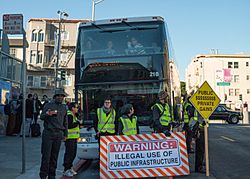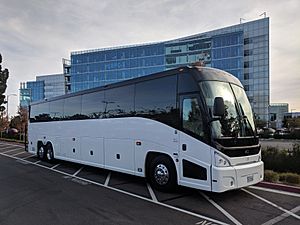San Francisco tech bus protests facts for kids
Quick facts for kids San Francisco tech bus protests |
|||
|---|---|---|---|

Protesters in San Francisco obstruct a bus carrying tech workers on December 9, 2013
|
|||
| Date | December 2013 – February 2016 | ||
| Location | |||
| Caused by | Direct cause Private transportation services operating parallel to municipal services Indirect cause Gentrification / Displacement |
||
| Methods |
|
||
| Resulted in | |||
| Parties to the civil conflict | |||
|
|||
The San Francisco tech bus protests were a series of protests in the San Francisco Bay Area. They started in late 2013. People were upset about private shuttle buses used by local tech companies. These buses were often called "Google buses." However, many other tech companies like Apple, Facebook, Yahoo, and Genentech also used them.
These buses took only tech employees from their homes in San Francisco and Oakland. They traveled to company offices in Silicon Valley, about 40 miles (64 km) south. Protesters saw the buses as a sign of gentrification. This is when a neighborhood changes, often making it too expensive for current residents. They also saw the buses as a sign of displacement. This means people are forced to move because of new developments. The tech industry grew very fast, but not enough new homes were built. This caused rents and housing prices to go up a lot.
Because of the protests, San Francisco started to regulate the shuttle services. This began in August 2014. Some bus stops were closed or moved. A permanent plan, called the Commuter Shuttle Program, started on February 1, 2016. This program made the shuttle services follow rules and pay fees to the city. This made their use more official. By May 2017, the protests had mostly stopped because of these new rules.
Contents
Why the Protests Happened
The main problems with the buses were two-fold. First, only employees of tech companies could use them. Second, for a long time, the buses used city streets and bus stops without paying the city. A professor from Berkeley, Abigail De Kosnik, said the protests showed how angry many San Francisco residents were. They felt that the wealth of tech companies was creating a bigger gap between rich and poor in the city. The protests were attempts to stop this unfairness.
Transportation Needs for Tech Workers
The tech industry in Silicon Valley grew a lot in the early 2000s. This brought many tech workers to the area. It also increased the need for public transportation in the wider Bay Area. There weren't enough good ways to get between San Francisco and Silicon Valley workplaces. So, in 2008, tech companies started using private buses. These buses gave employees an easy way to get to work. This also allowed tech workers to live outside Silicon Valley. A 2012 report said about 6,500 tech workers used these shuttle buses.
Rising Housing Costs
At the same time, the growth of tech companies led to gentrification. Rents were getting higher, and more people were being evicted by late 2013. The private bus services, along with the tech companies being located outside the city, made tech workers feel separate from other San Francisco residents. It was almost like living in a gated community. Some people felt that the buses showed how valuable tech workers were. They were seen as too important to use public transport or drive themselves.
Soon, people worried about the buses using public bus stops. When private shuttles and public buses tried to use the same stops without a plan, it caused traffic jams. The City of San Francisco was not getting paid for this use. A city report said that before August 2014, San Francisco did not regulate or charge fees for these shuttles. The shuttles stopped in many places, sometimes illegally. This caused confusion and problems with other types of transportation.
The Protests Begin
The protests began on December 9, 2013. Activists from a group called Heart of the City stopped a Google bus. This happened at 24th Street and Valencia in San Francisco's Mission District. The main way protesters acted was to briefly stop buses when they were picking up passengers. Then, the protest groups shared their actions with the media. This helped their message reach more people. Other groups in Oakland and even Seattle started protesting private tech buses in their areas too. Most of the time, protesters just blocked the buses from leaving their stops. On December 20, 2013, a group called Eviction Free San Francisco blocked a bus for 30 minutes. An organizer used a loudspeaker to draw attention to it.
On April 1, 2014, which was April Fools' Day, protesters dressed in blue, yellow, and red costumes. They blocked a Google bus at 24th and Valencia. An organizer pretended to be the president of a new Google bus division. She gave out fake passes, saying the public could ride the buses for free. When people tried to get on and were refused, the organizer admitted it was a joke. The bus was then allowed to leave.
In Oakland, across the bay, some protests were more intense. One protester broke a bus window. Another protester slashed a tire on a different bus. Other protesters in Oakland held up a banner with strong language. On April 2, 2014, a protester climbed onto the roof of a Yahoo bus near the Bay Area Rapid Transit's MacArthur station in Oakland. They vomited on the windshield. An organizer from San Francisco said the Oakland protests were not connected to the San Francisco groups. They said the only link was that many communities were being forced out, and people were very angry.
What Happened Next
Police Response
In most cases, protesters who blocked buses eventually moved. They either moved on their own or when police told them to. Very few arrests were made during the protests. This was because police often saw the actions as peaceful protests. San Francisco Police Department officers are trained to calm down situations. They use talking and other non-forceful ways to handle people who are not following orders.
City Government Meetings
The protests gained a lot of media and public attention. So, the San Francisco Board of Supervisors held a three-hour meeting about them. This happened at City Hall on January 7, 2014. Tech bus companies were offered a plan to pay $1 per stop per day. This fee would be charged no matter how many workers got on or off. Angry residents pointed out that San Franciscans paid $2 to ride city buses. They demanded that the private bus services pay more. The San Francisco Municipal Transportation Agency (SFMTA) was asked to gather information for a long-term solution. Six months later, in July 2014, SFMTA started charging a preliminary fee of $1.00 for each public stop used by the buses. This was expected to raise $1.5 million over 18 months.
Tech Companies' Actions
In February 2014, Google gave $6.8 million to SFMTA. This money was used to provide free public transit for low-income children in San Francisco. On March 31, 2014, a tech-support group called sf.citi spoke out. This group was led by Ron Conway, an early investor in Google. They supported SFMTA's pilot program.
The Solution
In 2015, SFMTA shared what they learned from their pilot program. They found that about 47% of tech workers would drive their own cars if they didn't have the tech buses. This would mean many more private cars on the roads. Because of this, SFMTA's board of directors approved a bigger plan. It was called the Commuter Shuttle Program. This program allowed the city to regulate the buses. It set rules for where they could travel, their size, and how much each bus had to pay the city for using city bus stops.
Some protests continued until February 2016. That's when SFMTA approved an extension to the program. This allowed it to continue beyond its first end date of March 31, 2017. This extension added stricter rules for the buses. It limited larger buses and required final approval for all main roads used. The city also provided safety training for the drivers. There would also be better coordination through constant GPS tracking of the buses. Finally, the extension made the city's ability to collect fees permanent. As of October 2018, the fee was $7.65 per stop.


